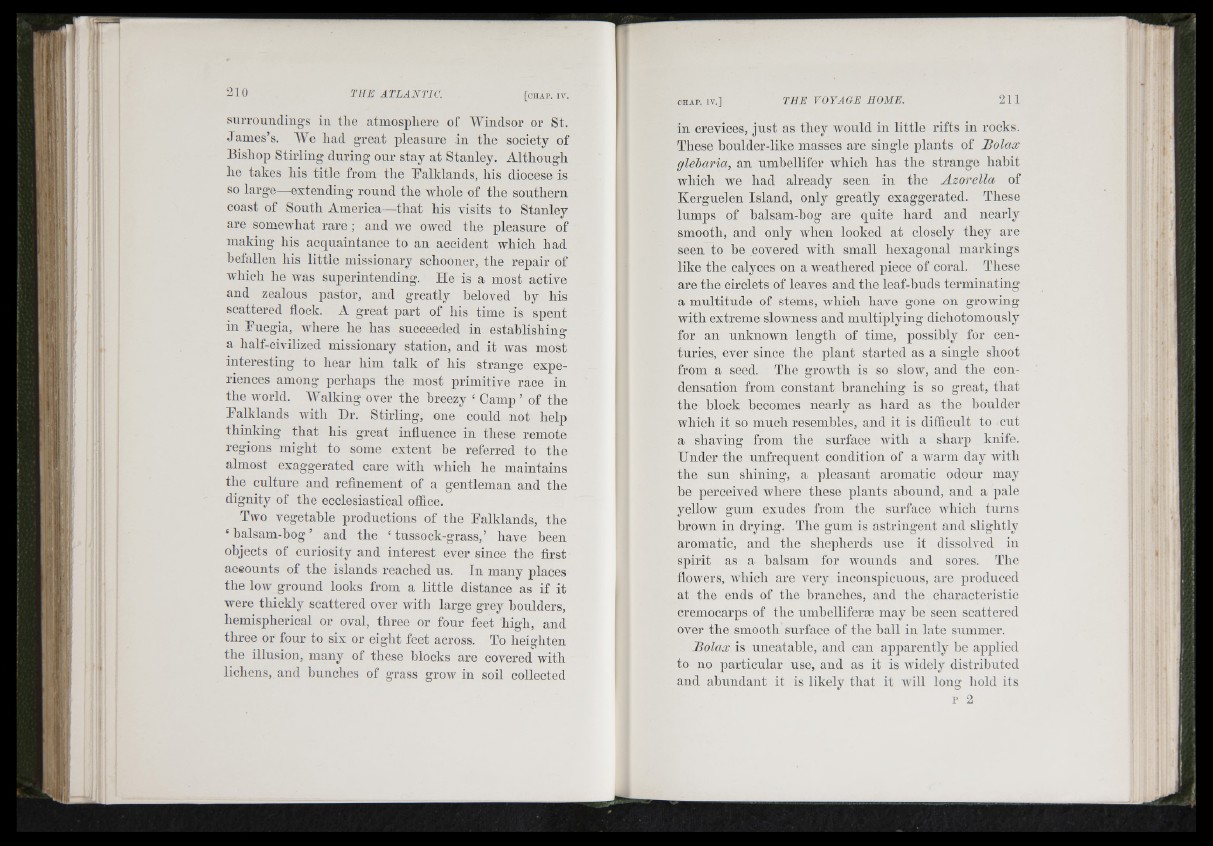
l|- i
E!"
surroundings in the atmosphere of AAhndsor or St.
James’s. AAY had great pleasure in the society of
Bishop Stirling during onr stay at Stanley. Although
he takes his title from the Palklands, his diocese is
so large—extending round the whole of the southern
coast of South America—that his A'isits to Stanley
are somendiat rare; and wq owed the pleasure of
making his acquaintance to an accident which had
befallen his little missionary schooner, the repair of
Avhich he was superintending. He is a most active
and zealous pastor, and greatly beloved hy his
scattered flock. A great part of his time is spent
in Puegia, where he has succeeded in establishing
a half-civilized missionary station, and it was most
interesting to hear him talk of his strange experiences
among perhaps the most primitive race in
the Avorld. AAYlking over the breezy ‘ Camp ’ of the
Palklands Avith Hr. Stirling, one could not help
thinking that his great influence in these remote
regions might to some extent be referred to tbe
almost exaggerated care Avitli Avliicli he maintains
the culture and refinement of a gentleman and the
dignity of the ecclesiastical office.
Two vegetable productions of the Palklands, the
‘ balsam-bog ’ and the ‘ tussock-grass,’ have been
objects of curiosity and interest ever since the first
aceounts of the islands reached us. In many places
the I oav ground looks from a little distance as i f it
Avere thickly scattered over Avitb large grey boulders,
hemispherical or oval, three or four feet high, and
three or four to six or eight feet across. To heighten
the illusion, many of these blocks are covered with
lichens, and bunches of grass groAv in soil collected
in crevices, ju s t as they Avould in little rifts in rocks.
These bonlder-like masses are single plants of Bolax
glebaria, an nmbellifer which has the strange habit
which we had already seen in. the Azorella of
Kerguelen Island, only greatly exaggerated. These
lumps of halsam-hog are quite hard and nearly
smooth, and only Avhen looked at closely they are
seen to he covered Avith small hexagonal markings
like the calyces on a Aveathered piece of coral. These
are the circlets of leaves and the leaf-huds terminating
a multitude of stems, Avhich have gone on groAving
Avith extreme sloAvness and multiplying dichotomonsly
for an unknown length of time, possibly for centuries,
ever since the plant started as a single shoot
from a seed. The groAvth is so slow, and the condensation
from constant branching is so great, th a t
the block becomes nearly as hard as the boulder
which it so much resembles, and it is difficult to cut
a shaving from the surface Avith a sharp knife.
Under the imfrequent condition of a Avarm day Avith
the sun shining, a pleasant aromatic odour may
be perceived where these plants abound, and a pale
yellow gum exudes from the surface Avhich turns
hroAvn in drying. The gum is astringent and slightly
aromatic, and the shepherds use it dissolved in
spirit as a balsam for Avonnds and sores. The
floAvers, Avhich are A'ery inconspicuous, are produced
at the ends of the branches, and the characteristic
cremocarps of the umhelliferse may he seen scattered
over the smooth surface of the hall in late summer.
Bolax i s n n e a t a h l e , a n d c a n a p p a r e n t l y be a p p l i e d
t o n o p a r t i c u l a r u s e , a n d a s i t i s A v i d e l y d i s t r i b u t e d
a n d a b u n d a n t i t i s l i k e l y t h a t i t A v i l l l o n gO h o l d i t s
p 2